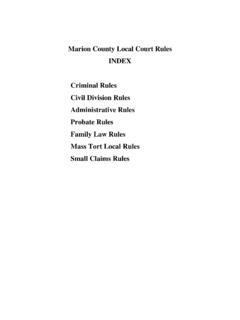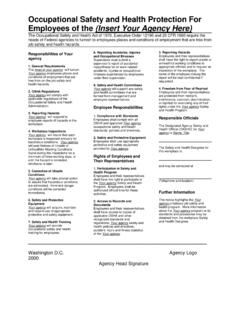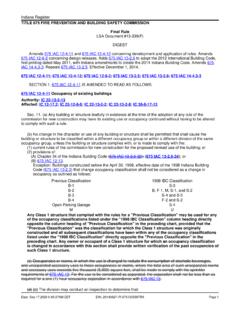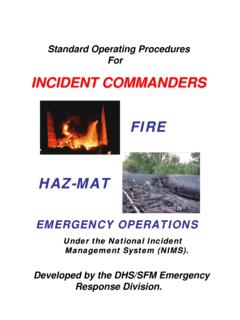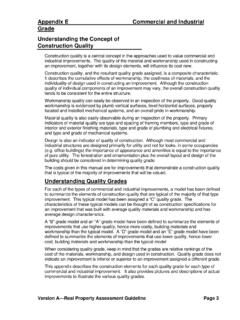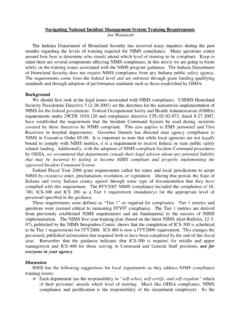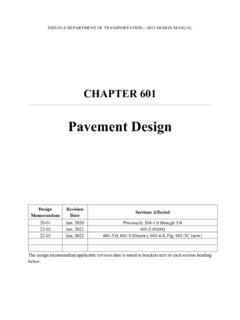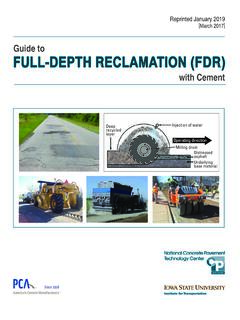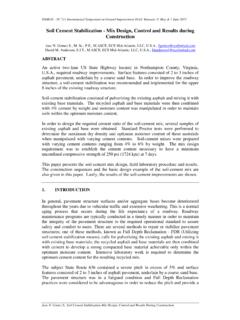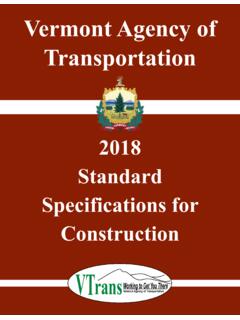Transcription of Project Categories and Pavement Types - Indiana
1 Indiana DEPARTMENT OF TRANSPORTATION 2013 DESIGN MANUAL. CHAPTER 602. Project Categories and Pavement Types Design Revision Sections Affected Memorandum Date 20-01 Jan. 2020 Previously through 20-15 Sep. 2020 , , , Figures 602-1B and 602-1C. 21-01 Jan. 2021 Figure 602-3Z. The design memorandum applicable revision date is noted in brackets next to each section heading below. TABLE OF CONTENTS. TABLE OF 2. LIST OF FIGURES .. 3. Pavement Project Categories [Rev. Sep. 2020].. 5. New Alignment .. 6. Pavement Reconstruction .. 6. Pavement 6. (01) Structural Overlay .. 6. (02) PCCP Rubblization and HMA Overlay .. 6. (03) PCCP Cracking and Seating and HMA Overlay .. 7. (04) Unbonded PCCP Overlay over Old PCCP .. 7. (05) Thin PCCP Overlay Bonded to Old Pavement .
2 8. (06) full depth Pavement reclamation .. 8. (07) Cold Central Plant 10. Preventive Maintenance .. 10. (01) Mill and Fill Overlay Treatment .. 11. (02) In-Place Recycling [Rev. Sep. 2020] .. 11. (03) Crack Sealing and 12. (04) Fog Sealing .. 12. (05) Seal Coat/Chip Seal .. 12. (06) Microsurfacing .. 13. (07) Ultrathin Bonded Wearing 13. (08) Concrete Pavement Restoration (CPR) [Rev. Sep. 2020] .. 14. (09) Concrete Pavement Preservation (CPP) [New Sep. 2020] .. 16. Pavement TYPE SELECTION .. 16. Pavement Types .. 17. Aggregate Pavement .. 18. Asphalt Pavement .. 19. (01) HMA / SMA Surface .. 21. (02) HMA Intermediate .. 21. (03) HMA Base .. 21. (04) Drainage Layer for HMA Pavement .. 21. (05) Separation Layer for HMA Pavement .
3 22. (06) Unbound Aggregate Base and Subbase Course .. 23. Portland Cement Concrete Pavement .. 23. (01) Drainage Layer for PCCP .. 24. (02) Separation Layer for PCCP .. 24. Composite Pavement .. 25. Page 2 2013 Indiana Design Manual, Ch. 602. Pavement Typical 25. 29. LIST OF FIGURES. Figure Title 602-1A Pavement Recycling Treatment Selection Flowchart 602-1B HMA Preventive Maintenance Treatments [Rev. Sep. 2020]. 602-1C PCCP Preventive Maintenance Treatments [Rev. Sep. 2020]. 602-3A full - depth HMA Pavement with full - depth Shoulder with Underdrain 602-3B full - depth HMA Pavement with full - depth Shoulder with Underdrain for Interstates and High-Volume Roadways 602-3C full - depth HMA Pavement with full - depth Shoulder without Underdrain 602-3D full - depth HMA Pavement with HMA on Compacted Aggregate Shoulder with Underdrain 602-3E full - depth HMA Pavement Example Sections 602-3F full - depth HMA Pavement Drainage and Separation Layers 602-3G full - depth HMA Pavement with HMA on Compacted Aggregate Shoulder without Underdrain 602-3H HMA on Compacted Aggregate Pavement 602-3 I Typical HMA Pavement on Compacted Aggregate 602-3J full - depth HMA Ramp 602-3K Underdrain for HMA Pavement with full - depth HMA Shoulder
4 602-3L Underdrain for full - depth HMA Pavement with HMA on Compacted Aggregate Shoulder 602-3M Concrete Curb and Gutter Section for HMA Pavement with Underdrain, Curb on HMA. Base 602-3N Concrete Curb and Gutter Section for HMA Pavement with Underdrain, Curb on Drainage Layer 602-3 O Concrete Curb and Gutter Section for HMA Pavement without Underdrain 602-3P Concrete Curb and Gutter Section for PCCP Pavement without Underdrain 602-3Q Modified Concrete Curb and Gutter Section for HMA Pavement on Compacted Aggregate without Underdrain 602-3R Modified Curb and Gutter Section for HMA or PCCP Pavement with Underdrain 602-3S PCCP Section with PCC Shoulder 602-3T PCCP Section with HMA Outside Shoulder 602-3U PCCP with Concrete Curb 602-3V PCCP Ramp 602-3W Underdrain for PCCP.
5 2013 Indiana Design Manual, Ch. 602 Page 3. 602-3X Underdrain for PCCP with HMA Shoulder 602-3Y Underdrain for Curbed PCCP. 602-3Z Median Edge of Concrete Pavement Longitudinal Joint Options 602-3AA Safety Edge 602-3BB Retrofit Underdrain 602-3CC HMA Pavement with Concrete Curb without Underdrain 602-3DD Aggregate Pavement 602-3EE Parking Lot Pavement Sections Page 4 2013 Indiana Design Manual, Ch. 602. CHAPTER 602. Project Categories AND Pavement Types . Pavement Project Categories [REV. SEP. 2020]. INDOT Pavement projects will fall in one of the following four Project Categories for Pavement design analysis: 1. New Alignment 2. Pavement Reconstruction 3. Pavement Rehabilitation a. Structural Overlay, major and minor b. PCCP Rubblization and HMA Overlay c.
6 PCCP Cracking and Seating and HMA Overlay d. Unbonded PCCP overlay over old PCCP. e. Thin Bonded Concrete Overlay f. full depth reclamation g. Cold Central Plant Recycling (CCPR). 4. Preventive Maintenance a. Surface Treatments b. HMA Mill and Fill Overlay c. In-Place Recycling Technologies (HIR, CIR). d. Crack Sealing and Filling e. Fog Seal f. Seal Coat/Chip Seal g. Microsurfacing h. Ultrathin Bonded Wearing Course i. Concrete Pavement Restoration (CPR). j. Concrete Pavement Preservation (CPP). k. Pavement Preservation Initiative (PPI). The Pavement should be designed in accordance with Section , MEPDG using AASHTOWare Pavement ME Design software. 2013 Indiana Design Manual, Ch. 602 Page 5. New Alignment New Alignment projects include Pavement designs that include recommendations for preparation of the subgrade and foundation soils if appropriate prior to placing the new unbound and bound Pavement layers.
7 Recommendations for New Alignment projects typically include a Pavement thickness for both asphalt and concrete Pavement . Pavement Reconstruction Pavement replacement projects include removal of the existing Pavement structure, including subbase when appropriate, and preparation of the foundation soil and subgrade if necessary prior to placing a new Pavement structure. Pavement damaged due to structural deficiencies should be considered for replacement. Pavement Rehabilitation Pavement Rehabilitation consists of structural enhancements that extend the life of an existing Pavement and/or improve its structural capacity. A widening component may be included with a rehabilitation or structural overlay Project . Rehabilitation techniques include restoration treatments and/or structural overlays.
8 A Pavement that is currently structurally insufficient or will be insufficient based on future traffic is a candidate for a rehabilitation type Project . (01) Structural Overlay The majority of Structural Overlay projects add Pavement structure with an overlay. This may include partial recycling of the existing Pavement , placement of additional surface materials, and/or other work necessary to return an existing Pavement to a condition of structural adequacy. A Pavement structural overlay will be by design, but may generally be: 1. A 2-layer HMA overlay, also known as minor structural treatment; or 2. A 3-layer HMA overlay, also known as major structural treatment. (02) PCCP Rubblization and HMA Overlay One effective way to rehabilitate a PCCP that has lost structural capacity is to rubblize the existing PCCP and overlay with HMA based on MEPDG design analysis.
9 Within MEPDG, the design type to be selected is that of a new design, however it should be noted that this is classified outside of the software as a Pavement rehabilitation treatment. Page 6 2013 Indiana Design Manual, Ch. 602. Refer to Standard Specifications Section 305 for construction requirements and surface preparation for rubblizing PCCP. Rubblizing consists of breaking the concrete into particles ranging from sand size to pieces not exceeding 6 in. in the largest dimension, with the majority being a nominal 1 to 2 in. in size. Rubblization should only be designed and constructed as an unbound Pavement subbase layer and not a drainage layer. A rubblized Pavement subbase layer will have a gradation that includes 0% passing 6 in.
10 And 40% passing 3 in. The concrete from the surface to the top of the reinforcements should be reduced to 1 to 2 in. in size to the fullest extent possible. Underdrains should be designed and placed along the edges of the Pavement prior to rubblization. Geotextile will not be required with underdrains when used with rubblization. Special attention should be made to the geotechnical report to determine if the soil type and characteristics are compatible with a recommendation for rubblization. (03) PCCP Cracking and Seating and HMA Overlay Another effective way to rehabilitate a PCCP that has lost structural capacity is to crack and seat the existing PCCP and overlay with HMA based on MEPDG analysis. Cracking and seating consist of cracking the existing PCCP Pavement and requires a unique special provision.

